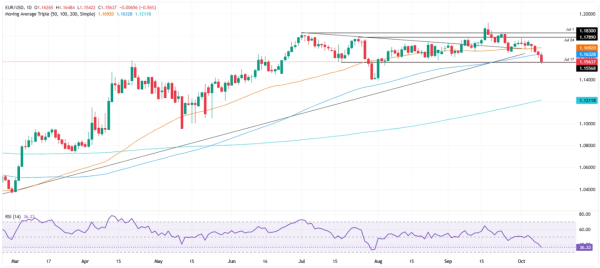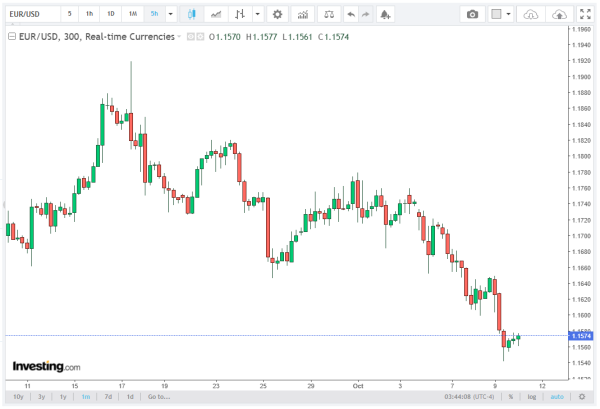The EUR/USD currency pair has experienced a sharp decline, tumbling below the 1.1600 figure and hitting an eight-week low near 1.1540. This drop comes amid heightened political uncertainty in France, weak German economic data, and a resilient US Dollar, fueled by ongoing Fed hawkishness and a prolonged US government shutdown.
The brokers at Solancie simplify the complexities of the issue in this detailed article. At the time of writing, EUR/USD trades at 1.1563, after reaching a daily high of 1.1648. The US Dollar Index (DXY) has extended its weekly rally, gaining 1.7%, reflecting a broader risk-off sentiment in global markets.
Political Turmoil in France Weighs on the Euro
The resignation of French Prime Minister Sebastien Lecornu has triggered concerns about France’s fiscal deficit and ongoing government stability. Investors are wary of the uncertainty surrounding negotiations with opposition parties and the timeline for President Emmanuel Macron to appoint a new Prime Minister.
This political upheaval has contributed to the Euro’s weakness, driving the EUR/USD lower. Markets reacted swiftly, with the Euro hitting 1.1542, marking its lowest level in two months. The resignation has also fueled fears that France’s public finances may come under further strain, pressuring investor confidence in European assets.
Soft German Data Adds to Euro Pressure
Adding to the Eurozone woes, recent German economic data disappointed. Exports missed estimates, while imports plunged more than expected, indicating potential slowdowns in trade activity.
The European Central Bank (ECB) minutes signaled a cautious approach amid persistent economic fragility. Officials acknowledged high uncertainty, particularly surrounding global trade policies, but saw no immediate need to adjust interest rates. The ECB’s stance reinforced the market’s perception of a fragile Eurozone economy, putting further pressure on EUR/USD.
USD Gains Amid US Government Shutdown and Fed Caution
Across the Atlantic, the US Dollar remains strong amid ongoing risk-off sentiment. The US government shutdown entered its ninth day, with little progress reported between House Republicans and Democrats.
Meanwhile, Fed officials remain cautious on inflation. Governor Michael Barr emphasized that tariffs are unlikely to spill over into services inflation, while suggesting a measured approach to future rate cuts. Minneapolis Fed President Neel Kashkari largely concurred with Barr’s assessment, reinforcing expectations for gradual monetary policy easing.

The DXY has climbed 1.7% this week, highlighting broad US Dollar strength against a basket of six major currencies. As EUR/USD falls, market participants are increasingly focused on risk sentiment and potential Fed rate decisions, with the probability of a 25-basis-point cut at the October 29 meeting standing at 94% according to Prime Market Terminal data.
Technical Outlook: EUR/USD Eyes Key Support Levels
EUR/USD has shifted to a downward-biased trend after breaking below the 20-day Simple Moving Average (SMA) at 1.1644 and the 1.1600 psychological level. The Relative Strength Index (RSI) is heading toward its neutral line, indicating that sellers are gaining momentum.
Immediate support for the pair is at 1.1550, followed by the 1.1500 level. If bearish momentum persists, the August 1 cycle low at 1.1391 could be tested.
On the upside, resistance levels are now set at 1.1600, followed by 1.1650 and 1.1700. Breaching 1.1700 would expose the 1.1800 area and the July 1 high at 1.1830, offering potential targets for Euro rebound scenarios.
Fed and ECB Comments Keep Markets on Edge
Fed minutes revealed policymakers’ ongoing debate over the appropriate response to evolving risks, particularly around inflation and employment conditions. Opinions remain split: nine officials favor two rate cuts, while Stephen Miren advocates several more, and nine others suggest one or no cuts.

New York Fed President John Williams highlighted the risks of a labor market slowdown, supporting additional rate cuts. Meanwhile, Fed Governor Michael Barr reiterated that current monetary policy remains appropriate, rates are modestly restrictive, and inflation risks warrant careful monitoring.
ECB officials remain cautious but steady, maintaining the current interest rate stance amid persistent uncertainty. This divergence between the US Fed and the ECB has contributed to the EUR/USD sell-off, reinforcing the Greenback’s appeal as a safe-haven asset.
Market Summary
The EUR/USD collapse below 1.1600 reflects a combination of political instability in France, weak German trade data, and robust USD demand amid risk-off sentiment. Technical indicators signal further downside potential toward 1.1500, while the DXY continues to extend weekly gains.
Investors remain attentive to upcoming economic releases, central bank communications, and political developments, which are expected to keep EUR/USD volatility elevated in the near term. The market will closely watch Fed rate decisions, ECB signals, and European political outcomes, which are likely to dictate the next major directional move for the Euro-Dollar pair.








